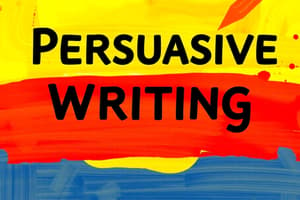Podcast
Questions and Answers
What is the purpose of using emotions in crafting messages?
What is the purpose of using emotions in crafting messages?
To evoke empathy, anger, or happiness.
How can one strengthen an argument in argumentative writing?
How can one strengthen an argument in argumentative writing?
By addressing potential counterarguments and rebutting them.
Why is it important to research both sides of a debatable issue in argumentative writing?
Why is it important to research both sides of a debatable issue in argumentative writing?
To gather evidence to support your argument.
What should be included in the conclusion of an argumentative essay?
What should be included in the conclusion of an argumentative essay?
What is the main goal of informative writing?
What is the main goal of informative writing?
How can understanding argumentative writing techniques help in communication?
How can understanding argumentative writing techniques help in communication?
How can you make informative writing effective?
How can you make informative writing effective?
What is the purpose of persuasive writing?
What is the purpose of persuasive writing?
What role do visual aids play in informative writing?
What role do visual aids play in informative writing?
How can you be successful in persuasive writing?
How can you be successful in persuasive writing?
Flashcards are hidden until you start studying
Study Notes
Writing is an essential skill that allows us to communicate effectively through written word. There are several writing techniques used depending on your purpose and audience. Here are some common styles and techniques for informative, persuasive, and argumentative writing:
Informative Writing Techniques
Informative writing aims to educate readers by providing them with facts, data, statistics, and examples related to a specific subject. To make informative writing effective, you can follow these techniques:
- Use Clear Language: Choose simple, concise, and jargon-free language that is easy to understand.
- Provide Context: Begin with background information to set the scene and explain why the topic is important or relevant.
- Organize Information: Structure your text logically so that it flows smoothly from one idea to another.
- Include Graphs or Charts: Visual representations of data help readers better grasp complex concepts.
- Cite Sources: Cite reputable sources to establish credibility and avoid plagiarism.
Persuasive Writing Techniques
Persuasive writing aims to convince readers to adopt a particular viewpoint or take action based on the writer's opinion or recommendation. Some techniques for persuasive writing include:
- Identify Your Audience: Understand who you want to influence and their perspective.
- State Your Position: Clearly state your position and the reasons behind it.
- Use Emotions: Craft messages that evoke emotions like empathy, anger, or happiness.
- Use Logical Appeals: Present evidence, arguments, and reasoning that appeals to logic.
- Anticipate Counterarguments: Address potential objections and rebut them.
Argumentative Writing Techniques
Argumentative writing aims to present a debatable issue and defend a specific stance while presenting evidence and arguments against opposing views. Some strategies for argumentative writing include:
- Choose a Controversial Topic: Select a topic that has multiple sides or points of view.
- Research Both Sides: Gather evidence from both sides of the debate to support your argument.
- Present Evidence: Present facts and figures that support your point of view.
- Address Counterarguments: Anticipate potential counterarguments and address them directly.
- Conclude with a Call to Action: End with a strong conclusion that leaves a lasting impression on your readers.
In conclusion, understanding these writing techniques can help you communicate more effectively and achieve your desired outcome whether you're writing to inform, persuade, or argue. Remember to always consider your audience, purpose, and tone when choosing your techniques to ensure your message resonates with your readers.
Studying That Suits You
Use AI to generate personalized quizzes and flashcards to suit your learning preferences.




